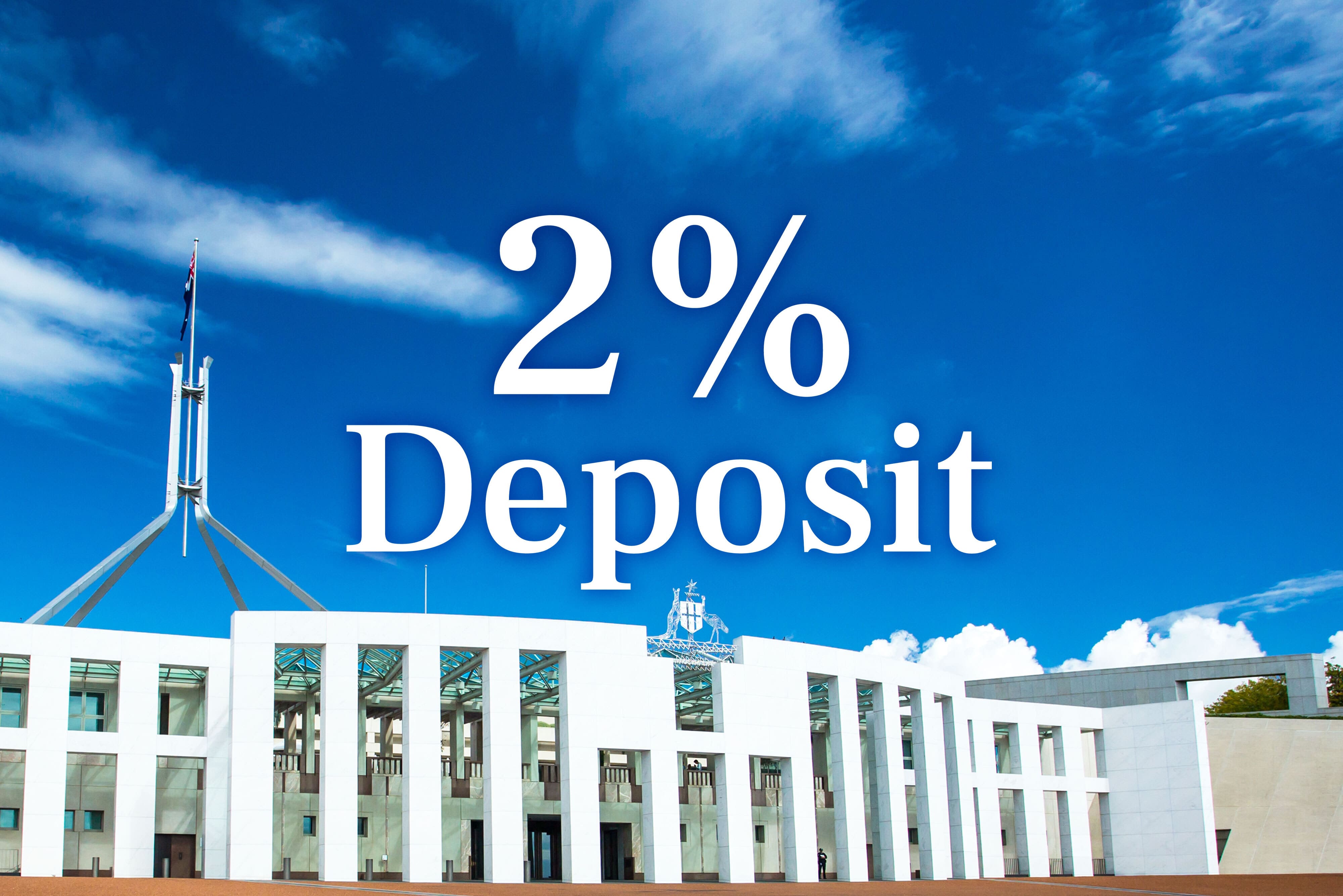Features > Property News & Insights > Investment News
New Government Scheme Allows Homebuyers to Purchase with a 2% Deposit

KEY POINTS
- A new Federal government scheme will enable buyers to purchase a home with as little as a 2% deposit, in return for “shared equity” in the property.
- Eligible families would receive a government equity contribution of up to 40 per cent of the cost of a new home, or 30 per cent for existing homes
- Successful applicants won’t need to pay rent on the share of their house, which is owned by the government.
- To qualify, you must earn less than $90,000 a year if you are single or $120,000 if you are a couple, and you must live in the home.
One of the main barriers to homeownership for young and lower-income Australians is coming up with a decent deposit.
According to the Australian Housing and Urban Research Institute, the time needed for a wage earner on the median income to save a 20% deposit for a typical property has blown out from six years in 1994 to 14 years today.
Commenting on those figures, ABC Business reporter Gareth Hutchens wrote:
“Think about what that means.”
“Think of the extra hours of work that are now being demanded from first home buyers just so they can get to the starting line.”
There’s always been the option to purchase a property with a lower deposit, by taking out Lender’s Mortgage Insurance.
However, the higher costs associated with what is essentially an insurance policy for a risker loan can end up locking out many would-be home buyers.
Government-shared equity
One way around this “deposit dilemma” is a new Federal government scheme that enables buyers to purchase a home with as little as a 2% deposit, in return for “shared equity” in the property.
Last week, the Albanese government unveiled the proposed legislation for its “Help to Buy” plan in parliament.
Starting next year, the scheme would allow 40,000 low-and middle-income families to get into the property market with small deposits.
Eligible families would receive what’s called an "equity contribution" from the government of up to 40 per cent of the cost of a new home, or 30 per cent for existing homes.
One of the great ongoing advantages for people who take part in the scheme is that they don’t need to pay rent on the share of their house, which is owned by the government.
However, if they sell the property, they have to pay the government back its original stake, plus a share (corresponding to the government’s stake) of any capital gains.
As people build up equity in their homes and build their own wealth, they can also progressively “buy out” the government’s stake at an agreed market rate.
“Right across the country, Help to Buy will be life-changing, bringing home ownership back into reach for thousands of Australians, particularly renters,” says the Federal Housing Minister Julie Collins.
“It won’t just be a leg up into home ownership with savings from a smaller deposit – it will provide long‑term relief to Australians who are part of the Scheme.
“In fact, Help to Buy could help eligible new homeowners save hundreds every month on their mortgage,” she says.

The fine print
There are plenty of eligibility rules for the Federal government’s scheme.
Firstly, you must have enough money for at least a 2% home deposit.
You must be an Australian citizen, and at the time of purchase, you can’t own any other property in Australia or overseas.
To qualify, you must earn less than $90,000 a year if you are single or $120,000 if you are a couple, and you must live in the home.
You cannot treat it as an investment property.
There are also limits on the price of a home you can apply to buy.
That’s calculated based on median home values in the state where you live, and the cap is smaller if you live outside a capital or large regional city.

Similar state schemes
Although this is a Federal government scheme, each state will have to pass their own laws to make sure Help to Buy can operate in their jurisdiction.
Julie Collins says the states have already agreed at the National Cabinet to progress legislation so the Scheme can get up and running next year.
But the Albanese government has to get the scheme through the Federal parliament first, and at this stage, with the Opposition opposed, it still doesn’t have the required support from the Greens or the crossbench.
One of the reasons for getting the states involved is that a number already have experience in delivering this kind of service.
Existing government-subsidised purchase schemes are already in place in several states, including New South Wales, Victoria, Western Australia and Queensland.
For example, the current New South Wales scheme targets essential workers like nurses, midwives, paramedics, teachers, early childhood educators and police officers, who are increasingly being locked out of home ownership in expensive cities like Sydney.
It’s also aimed at single parents and older singles who don’t yet own their own home.
Cameron Kusher is Director of Economic Research at REA Group, which publishes “PropTrack” data.
"Taxpayer-wise, it is basically a free loan that is being given to help people get into the market", he told the ABC.
"But I think it is a case of taxpayers taking one for the team to help those less fortunate in this high interest rate and high property price market."
Stay Up to Date
with the Latest Australian Property News, Insights & Education.




.png?width=292&height=292&name=Copy%20Link%20(1).png)
 SIGN UP FOR FREE NEWSLETTER
SIGN UP FOR FREE NEWSLETTER
%20(1).png)

.png)





.jpg?width=1920&height=1080&name=Warning%2c%20You%20Might%20Be%20Facing%20Higher%20Taxes%20Soon%20(1).jpg)





.png?width=1920&height=1080&name=Rate%20Drops%20Signal%20BIGGEST%20Property%20Boom%20in%20DECADES%20(1).png)

.jpg?width=1920&height=1080&name=Labor%20vs%20Liberal%20These%20Housing%20Policies%20Could%20Change%20the%20Property%20Market%20Forever%20(1).jpg)
.jpg?width=1920&height=1080&name=QLD%20Slashes%20Stamp%20Duty%20Big%20News%20for%20Investors%20%26%20Home%20Buyers%20(1).jpg)
.jpg?width=1920&height=1080&name=Trump%20Just%20Slapped%20Tariffs%20%E2%80%93%20Here%E2%80%99s%20What%20It%20Means%20for%20Australia%20(1).jpg)
.jpg?width=1920&height=1080&name=Federal%20Budget%202025%20More%20Debt%2c%20No%20Housing%20%E2%80%93%20Here%E2%80%99s%20What%20You%20Need%20to%20Know%20(1).jpg)
.jpg?width=1920&height=1080&name=Australias%20Housing%20Crisis%20is%20about%20to%20get%20MUCH%20Worse%20(New%20Data%20Warns).jpg)
%20(1).jpg?width=1920&height=1080&name=Australias%20RENTAL%20CRISIS%20Hits%20ROCK%20BOTTOM!%20(2025%20Update)%20(1).jpg)
%20(1).png?width=1920&height=1080&name=Is%20Adelaide%20Still%20a%20Good%20Property%20Investment%20(2025%20UPDATE)%20(1).png)
.jpg?width=1920&height=1080&name=RBA%20Shocks%20with%20Rate%20Cuts!%20What%E2%80%99s%20Next%20for%20Property%20Investors%20(1).jpg)
%20(1).jpg?width=1920&height=1080&name=I%20Predict%20The%20Feb%20Rate%20Cut%20(My%20Price%20Growth%20Prediction)%20(1).jpg)
.png?width=1920&height=1080&name=Why%20Property%20Prices%20Will%20Rise%20in%202025%20Market%20Predictions%20(1).png)
.jpg?width=1920&height=1080&name=Why%20Investors%20Are%20Choosing%20Apartments%20Over%20Houses%202%20(1).jpg)
.jpg?width=1920&height=1080&name=Why%20Rate%20Cuts%20Will%20Trigger%20A%20Property%20Boom%20(1).jpg)
.jpg?width=1920&height=1080&name=Retire%20On%202Million%20With%20One%20Property%20(Using%20SMSF).jpg)
.jpg?width=1920&height=1080&name=4%20Reasons%20Why%20You%20Should%20Invest%20in%20Melbourne%20Now%20(1).jpg)
%20(1).jpg?width=1920&height=1080&name=Old%20Property%20vs%20New%20Property%20(Facts%20and%20Figures%20Revealed)%20(1).jpg)
%20(1).jpg?width=1920&height=1080&name=Will%20The%20New%20QLD%20Govt%20Create%20a%20Property%20Boom%20or%20Bust%20(My%20Prediction)%20(1).jpg)
%20Scott%20Kuru%20(1).jpg?width=1920&height=1080&name=Inflation%20Hits%20Three-Year%20Low%20(Will%20RBA%20Cut%20Rates%20Soon)%20Scott%20Kuru%20(1).jpg)
.jpg?width=1920&height=1080&name=How%20to%20Buy%20Investment%20Property%20Through%20SMSF_%20The%20Ultimate%20Guide%20(1).jpg)
.jpg?width=1920&height=1080&name=Victoria%20Slashes%20Stamp%20Duty%20Melbourne%20Set%20to%20Boom%20Scott%20Kuru%20(1).jpg)
.png?width=1571&height=861&name=Are%20Foreign%20Buyers%20Really%20Driving%20Up%20Australian%20Property%20Prices%20(1).png)
.jpg?width=1920&height=1080&name=The%20Single%20Factor%20That%20Predicts%20Property%20Growth%20Regions%20(1).jpg)
%20Scott%20Kuru%20(1).jpg?width=1920&height=1080&name=My%20Prediction%20On%20Rates%20%26%20Negative%20Gearing%20(Market%20Crash)%20Scott%20Kuru%20(1).jpg)

-1.png?width=1920&height=1080&name=Major%20Banks%20Cut%20Rates%20Will%20RBA%20Follow%20Suit%20(Sept%20Rate%20Update)-1.png)
%20Scott%20Kuru-1.png?width=1920&height=1080&name=Rate%20Cut%20Coming%20What%20New%20Zealands%20Move%20Means%20for%20Australia%20(Sept%20Prediction)%20Scott%20Kuru-1.png)
%20(1).jpg?width=1920&height=1080&name=Buy%20when%20the%20interest%20rates%20are%20high!%20(Why%20you%20must%20buy%20now!)%20(1).jpg)
.jpg?width=1920&height=1080&name=Carms_Revised%20Taxes%20Due%20Aug%209%20YT%20Thumbnail02%20(1).jpg)
.jpg?width=1920&height=1080&name=Carms_Too%20Little%20Too%20Late%20Aug%207%20YT%20Thumbnail01%20(1).jpg)









.jpg?width=1920&height=1080&name=Carms_Rate%20Drop%20In%20July%20Jun%2010%20YT%20Thumbnail02%20(1).jpg)
.jpg?width=1920&height=1080&name=Carms_Own%20a%20Property%20V6%20Jun%205_YT%20Thumbnail%20(1).jpg)









.png?width=1920&height=1080&name=Artboard%201%20(3).png)






.jpg?width=1920&height=1080&name=YT%20thumbnail%20%20(1).jpg)

